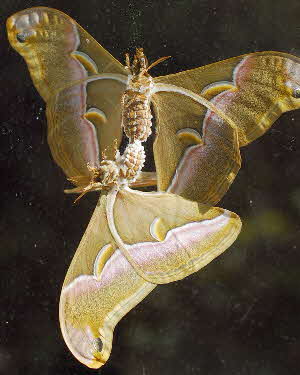|
There are several species of tussah silk moths (family Saturniidae) in China, India, Japan, Africa and North America. The moths are large and have a prominent eye marking on their wings. The caterpillars are bright green, as wide as a man’s finger and they feed on a wide range of plants.
The most important tussah silk moths are
a) Chinese Tussah Silkmoth (Antheraea pernyi): most commercial tussah silk comes from the Chinese Tussah Moth which is reared on Chinese oak. The moth is fawn colour and the wingspan is 10 to 15 cm. The cocoon is large, brown, hard and solid.
b) Indian Tussah Silkmoth or Tasar Silkmoth (Antherea myllita): traditionally tasar silk was reeled from cocoons collected from the wild but the yields are poor. Tasar silk production underwent a revival with better training for rearers, reelers and weavers provided by PRADAN, an Indian NGO. They improved the supply with disease free eggs and provided training on silkworm rearing. They also planted and pruned food trees for the caterpillars on privately-owned lands and kept the caterpillars on trees protected under netting.
 c) Indian Muga Silkmoth (Antheraea assamensis) from Brahmaputra: the caterpillar spins a golden silk which is rarely exported. Both Muga and Tasar silk are sold mainly as woven fabrics. c) Indian Muga Silkmoth (Antheraea assamensis) from Brahmaputra: the caterpillar spins a golden silk which is rarely exported. Both Muga and Tasar silk are sold mainly as woven fabrics.
d) Japanese Tensan Silkmoth (Antheraea yamamai): cultivated for more than 1000 years. This silk is yellowy-green and very strong and elastic. Japanese Tensan Silkmoth caterpillars are smaller than other tussah species and eat oak leaves; the cocoon is yellow-green. The silk is now very rare and expensive.
e) Chinese Eri silkmoth (Samia cynthia and S. cynthia ricini): is in the same family as tussah silk moths. The cocoon is spun between leaves, and is somewhat triangular in cross-section. The silk cannot be reeled and has to be spun. It looks a bit like cotton but still feels like silk. Different varieties of Eri silkmoth caterpillars eat the leaves of several plants, including castor oil, manioc and privet.
Back to Tussah Silk page.
Top of page
|

